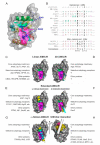Atg8-Family Proteins-Structural Features and Molecular Interactions in Autophagy and Beyond
- PMID: 32882854
- PMCID: PMC7564214
- DOI: 10.3390/cells9092008
Atg8-Family Proteins-Structural Features and Molecular Interactions in Autophagy and Beyond
Abstract
Autophagy is a common name for a number of catabolic processes, which keep the cellular homeostasis by removing damaged and dysfunctional intracellular components. Impairment or misbalance of autophagy can lead to various diseases, such as neurodegeneration, infection diseases, and cancer. A central axis of autophagy is formed along the interactions of autophagy modifiers (Atg8-family proteins) with a variety of their cellular counter partners. Besides autophagy, Atg8-proteins participate in many other pathways, among which membrane trafficking and neuronal signaling are the most known. Despite the fact that autophagy modifiers are well-studied, as the small globular proteins show similarity to ubiquitin on a structural level, the mechanism of their interactions are still not completely understood. A thorough analysis and classification of all known mechanisms of Atg8-protein interactions could shed light on their functioning and connect the pathways involving Atg8-proteins. In this review, we present our views of the key features of the Atg8-proteins and describe the basic principles of their recognition and binding by interaction partners. We discuss affinity and selectivity of their interactions as well as provide perspectives for discovery of new Atg8-interacting proteins and therapeutic approaches to tackle major human diseases.
Keywords: Atg8; GABARAP; LC3; LIR motif; SAR; UBL; autophagy.
Conflict of interest statement
The authors declare no conflict of interest.
Figures





Similar articles
-
Human LC3 and GABARAP subfamily members achieve functional specificity via specific structural modulations.Autophagy. 2020 Feb;16(2):239-255. doi: 10.1080/15548627.2019.1606636. Epub 2019 Apr 28. Autophagy. 2020. PMID: 30982432 Free PMC article.
-
An atypical LIR motif within UBA5 (ubiquitin like modifier activating enzyme 5) interacts with GABARAP proteins and mediates membrane localization of UBA5.Autophagy. 2020 Feb;16(2):256-270. doi: 10.1080/15548627.2019.1606637. Epub 2019 Apr 28. Autophagy. 2020. PMID: 30990354 Free PMC article.
-
Phosphorylation of the LIR Domain of SCOC Modulates ATG8 Binding Affinity and Specificity.J Mol Biol. 2021 Jun 25;433(13):166987. doi: 10.1016/j.jmb.2021.166987. Epub 2021 Apr 24. J Mol Biol. 2021. PMID: 33845085 Free PMC article.
-
Selective Autophagy: ATG8 Family Proteins, LIR Motifs and Cargo Receptors.J Mol Biol. 2020 Jan 3;432(1):80-103. doi: 10.1016/j.jmb.2019.07.016. Epub 2019 Jul 13. J Mol Biol. 2020. PMID: 31310766 Review.
-
Mechanisms of Selective Autophagy.Annu Rev Cell Dev Biol. 2021 Oct 6;37:143-169. doi: 10.1146/annurev-cellbio-120219-035530. Epub 2021 Jun 21. Annu Rev Cell Dev Biol. 2021. PMID: 34152791 Review.
Cited by
-
Overexpression of TP53INP2 Promotes Apoptosis in Clear Cell Renal Cell Cancer via Caspase-8/TRAF6 Signaling Pathway.J Immunol Res. 2022 May 14;2022:1260423. doi: 10.1155/2022/1260423. eCollection 2022. J Immunol Res. 2022. PMID: 35615533 Free PMC article.
-
The Molecular Mechanism and Therapeutic Application of Autophagy for Urological Disease.Int J Mol Sci. 2023 Oct 4;24(19):14887. doi: 10.3390/ijms241914887. Int J Mol Sci. 2023. PMID: 37834333 Free PMC article. Review.
-
The nonautophagic functions of autophagy-related proteins.Autophagy. 2024 Apr;20(4):720-734. doi: 10.1080/15548627.2023.2254664. Epub 2023 Sep 8. Autophagy. 2024. PMID: 37682088 Free PMC article. Review.
-
Monitoring Autophagy in Human Aging: Key Cell Models and Insights.Front Biosci (Landmark Ed). 2025 Mar 20;30(3):27091. doi: 10.31083/FBL27091. Front Biosci (Landmark Ed). 2025. PMID: 40152379 Free PMC article. Review.
-
Stress-induced microautophagy is coordinated with lysosome biogenesis and regulated by PIKfyve.Mol Biol Cell. 2024 May 1;35(5):ar70. doi: 10.1091/mbc.E23-08-0332. Epub 2024 Mar 27. Mol Biol Cell. 2024. PMID: 38536415 Free PMC article.
References
Publication types
MeSH terms
Substances
Grants and funding
LinkOut - more resources
Full Text Sources
Other Literature Sources
Miscellaneous

